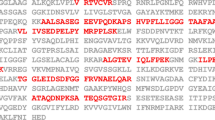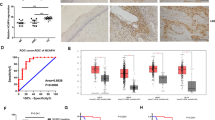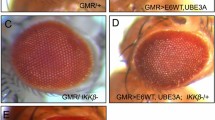Abstract
Oncogenic types of human papillomaviruses (HPVs) cause cervical cancer in humans. The antiapoptotic viral E6 gene has been identified as a key factor for maintaining the viability of HPV-positive cancer cells. Although E6 has the potential to modulate many apoptosis regulators, the crucial apoptotic pathway blocked by endogenous E6 in cervical cancer cells remained unknown. Using RNA interference (RNAi), here, we show that targeted inhibition of E6 expression in cervical cancer cells leads to the transcriptional stimulation of the PUMA promoter, in a p53-dependent manner. This is linked to the activation and translocation of Bax to the mitochondrial membrane, cytochrome c release into the cytosol, and activation of caspase-3, in a PUMA-dependent manner. Moreover, inhibition of Bax expression by RNAi efficiently reverts the apoptotic phenotype, which results from inhibition of E6 expression. Thus, interference with the p53/PUMA/Bax cascade is crucial for the antiapoptotic function of the viral E6 oncogene in HPV-positive cancer cells.
This is a preview of subscription content, access via your institution
Access options
Subscribe to this journal
Receive 50 print issues and online access
$259.00 per year
only $5.18 per issue
Buy this article
- Purchase on Springer Link
- Instant access to full article PDF
Prices may be subject to local taxes which are calculated during checkout





Similar content being viewed by others
References
Aguilar-Lemarroy A, Gariglio P, Whitaker NJ, Gariglio P, zur Hausen H, Krammer PH et al. (2002). Oncogene 21: 165–175.
Baldus SE, Schwarz E, Lohrey C, Zapatka M, Landsberg S, Hahn SA et al. (2005). Oncogene 24: 810–819.
Brummelkamp TR, Bernards R, Agami R . (2002). Science 296: 550–553.
Butz K, Denk C, Ullmann A, Scheffner M, Hoppe-Seyler F . (2000). Proc Natl Acad Sci USA 97: 6693–6697.
Butz K, Ristriani T, Hengstermann A, Denk C, Scheffner M, Hoppe-Seyler F . (2003). Oncogene 22: 5938–5945.
Chen C, Okayama H . (1987). Mol Cell Biol 7: 2745–2752.
DeFilippis RA, Goodwin EC, Wu L, DiMaio D . (2003). J Virol 77: 1551–1563.
Desaintes C, Goyat S, Garbay S, Yaniv M, Thierry F . (1999). Oncogene 18: 4538–4545.
Evan GI, Vousden KH . (2001). Nature 411: 342–348.
Filippova M, Parkhurst L, Duerksen-Hughes PJ . (2004). J Biol Chem 279: 25729–25744.
Goodwin EC, Yang E, Lee CJ, Lee HW, DiMaio D, Hwang ES . (2000). Proc Natl Acad Sci USA 97: 10978–10983.
Gu J, Zhang L, Swisher SG, Liu J, Roth JA, Fang B . (2004). Oncogene 23: 1300–1307.
Hall AH, Alexander KA . (2003). J Virol 77: 6066–6069.
Hengstermann A, D'silva MA, Kuballa P, Butz K, Hoppe-Seyler F, Scheffner M . (2005). J Virol 79: 9296–9300.
Horner SM, DeFilippis RA, Manuelidis L, DiMaio D . (2004). J Virol 78: 4063–4073.
Hsu YT, Youle RJ . (1998). J Biol Chem 273: 10777–10783.
Kaeser MD, Iggo RD . (2002). Proc Natl Acad Sci USA 99: 95–100.
Kelley ML, Keiger KE, Lee CJ, Huibregtse JM . (2005). J Virol 79: 3737–3747.
Klingelhutz AJ, Foster SA, McDougall JK . (1996). Nature 380: 79–82.
Kong XT, Gao H, Stanbridge EJ . (2001). J Biol Chem 276: 32990–33000.
Liu J, Wei T, Kwang J . (2004). Virology 318: 169–182.
Magal SS, Jackman A, Ish-Shalom S, Botzer LE, Gonen P, Schlegel R et al. (2005). J Gen Virol 86: 611–621.
Melino G, Bernassola F, Ranalli M, Yee K, Zong WX, Corazzari M et al. (2004). J Biol Chem 279: 8076–8083.
Miyashita T, Reed JC . (1995). Cell 80: 293–299.
Nakano K, Vousden KH . (2001). Mol Cell 7: 683–694.
Pan H, Griep AE . (1995). Genes Dev 9: 2157–2169.
Psyrri A, DeFilippis RA, Edwards AP, Yates KE, Manuelidis L, DiMaio D . (2004). Cancer Res 64: 3079–3086.
Samali A, Cai J, Zhivotovsky B, Jones DP, Orrenius S . (1999). EMBO J 18: 2040–2048.
Scheffner M, Werness BA, Huibregtse JM, Levine AJ, Howley PM . (1990). Cell 63: 1129–1136.
Stöppler H, Conrad Stöppler M, Johnson E, Simbulan-Rosenthal CM, Smulson ME, Iyer S et al. (1998). Oncogene 17: 1207–1214.
Thomas M, Banks L . (1998). Oncogene 17: 2943–2954.
Wells SI, Francis DA, Karpova AY, Dowhanick JJ, Benson JD, Howley PM . (2000). EMBO J 19: 5762–5771.
Yu L, Zhang L, Hwang PM, Kinzler KW, Vogelstein B . (2001). Mol Cell 7: 673–682.
Yuan H, Fu F, Zhuo J, Wang W, Nishitani J, An DS et al. (2005). Oncogene 24: 5069–5078.
Zhang HM, Yuan J, Cheung P, Chau D, Wong BW, MacManus BM et al. (2005). Mol Cell Biol 25: 6247–6258.
zur Hausen H . (2002). Nat Rev Cancer 2: 342–350.
Acknowledgements
We thank Claudia Lohrey for expert technical assistance and Dr Martin Scheffner for valuable discussion. We are grateful to Drs Reuven Agami, Eric Stanbridge and Bert Vogelstein for the generous gift of plasmids. This work was supported by the Wilhelm-Sander Stiftung (FH-S) and the Deutsche Krebshilfe (FH-S).
Author information
Authors and Affiliations
Corresponding author
Rights and permissions
About this article
Cite this article
Vogt, M., Butz, K., Dymalla, S. et al. Inhibition of Bax activity is crucial for the antiapoptotic function of the human papillomavirus E6 oncoprotein. Oncogene 25, 4009–4015 (2006). https://doi.org/10.1038/sj.onc.1209429
Received:
Revised:
Accepted:
Published:
Issue Date:
DOI: https://doi.org/10.1038/sj.onc.1209429
Keywords
This article is cited by
-
Human papillomavirus infection, cervical cancer and the less explored role of trace elements
Biological Trace Element Research (2023)
-
HPV-mediated nuclear export of HP1γ drives cervical tumorigenesis by downregulation of p53
Cell Death & Differentiation (2020)
-
Systems-level effects of ectopic galectin-7 reconstitution in cervical cancer and its microenvironment
BMC Cancer (2016)
-
Polymorphism in apoptotic BAX (-248G>A) gene but not in anti-apoptotic BCL2 (-938C>A) gene and its protein and mRNA expression are associated with cervical intraepithelial neoplasia
Apoptosis (2015)
-
Nip the HPV encoded evil in the cancer bud: HPV reshapes TRAILs and signaling landscapes
Cancer Cell International (2013)



